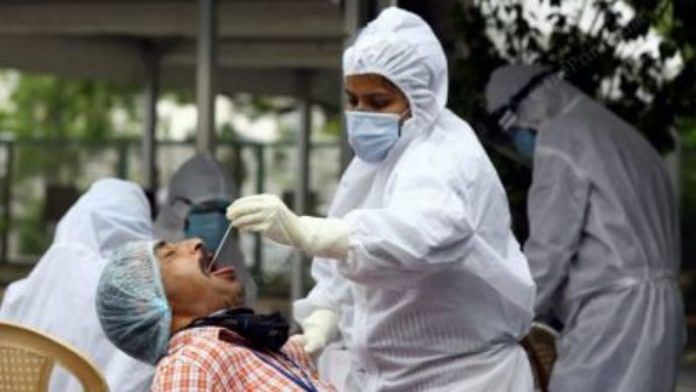New Delhi: For the first time in over two months, India’s R-value for Covid-19 — an indicator of how fast the infection is spreading — has increased, going from 0.78 on 30 June to 0.88 in the first week of July, according to researchers at the Chennai-based Institute of Mathematical Sciences.
The R-value had remained at 0.78 for over 20 days beginning 8 June, Sitabhra Sinha, a researcher at the institute, said.
With the R-value still below 1, however, active cases in the country continue to decline. But the rise means the decline is now slower than before.
R-value estimates the number of people who can catch infection from one sick person. The pandemic can only come to an end if the figure is sustained under 1.
At 0.78 through most of June, India’s R-value had been the lowest since the beginning of the pandemic.
“The trend of slowing down the rate of decrease in active cases is also seen in many states,” Sinha, who has been tracking the R-value figures since the beginning of the pandemic, told ThePrint.
He added that the last time the R-value saw an increasing trend was from February this year, when it rose from 0.93 on the 19th to 1.02 on the 26th. It continued rising through March and April, when the country witnessed the devastating second wave, to reach a peak of 1.31 on 26 April. Since then, it had been declining until the latest spurt.
The rise in R-value, Sinha said, seems to be primarily driven by its increase in Kerala and Maharashtra — the two states with the highest burden of active Covid cases.
Also read: How climate is changing our body size, and why our ‘brains are shrinking’
Rise in Maharashtra, Kerala
For Maharashtra, the R-value has been steadily increasing over the past several weeks. Between 13 and 23 May, the R-value for the state had fallen to 0.79. By 30 May, it had increased to 0.84.
While the value dropped a little to 0.81 around 8 June, it once again increased to 0.89 by 25 June, Sinha said. At present, Sinha added, the value has further increased and is close to 1, although he could not make a robust estimate.
In the case of Kerala, the value of R has been increasing since May. The R-value increased to 1.10 at the beginning of this month. Sinha said, like Maharashtra, Kerala too has an R-value close to 1 at present.
For Tamil Nadu, the R-value has increased to 0.90, from 0.63 through June. Similarly, Andhra Pradesh saw its R-value rise to 0.87 this week, from 0.79 around 26 June.
Uttarakhand, another state that has among the highest active cases, has also witnessed an increase in R-value. Until around 15 June, the state’s R-value was 0.79. This has now increased to 0.94.
Other regions with high R-value
The northeastern states are all simultaneously seeing a rise in R-value. Manipur’s R-value was as low as 0.43 around 26 June. This has rapidly increased to 1.07.
In Meghalaya, the R-value increased to 0.92 around 7 July, from 0.87 on 29 June.
Tripura’s R-value also increased to 1.15 this week, from around 0.73 until about 2 July.
Arunachal Pradesh and Sikkim have recorded a similar trend, with the R-value having increased to 1.14 and 0.88, from 0.88 and 0.85, respectively.
An increasing trend in the value may predict the coming of the next Covid wave.
Before India’s second wave for example, the R-value had stopped declining in January and had begun to increase in February. This led to an unprecedented rise in numbers by March.
(Edited by Arun Prashanth)
Also read: Covaxin offers significant protection against Beta, Delta variants, ICMR study says



